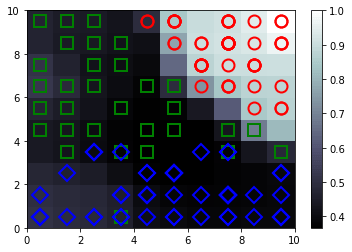3 releases (stable)
| 1.1.1 | Apr 1, 2020 |
|---|---|
| 1.0.0 | Mar 18, 2018 |
| 0.1.0 | Mar 10, 2018 |
#294 in Machine learning
38KB
294 lines
RusticSOM
Rust library for Self Organising Maps (SOM).
Using this Crate
Add rusticsom as a dependency in Cargo.toml
[dependencies]
rusticsom = "1.1.0"
Include the crate
use rusticsom::SOM;
API
Use SOM::create to create an SOM object using the API call below, which creates an SOM with length x breadth cells and accepts neurons of length inputs.
pub fn create(length: usize, breadth: usize, inputs: usize, randomize: bool, learning_rate: Option<f32>, sigma: Option<f32>, decay_function: Option<fn(f32, u32, u32) -> f64>, neighbourhood_function: Option<fn((usize, usize), (usize, usize), f32) -> Array2<f64>>) -> SOM { ... }
randomize is a flag, which, if true, initializes the weights of each cell to random, small, floating-point values.
learning_rate, optional, is the learning_rate of the SOM; by default it will be 0.5.
sigma, optional, is the spread of the neighbourhood function; by default it will be 1.0.
decay_function, optional, is a function pointer that accepts functions that take 3 parameters of types f32, u32, u32, and returns an f64. This function is used to "decay" both the learning_rate and sigma. By default it is
new_value = old_value / (1 + current_iteration/total_iterations)
neighbourhood_function, optional, is also a function pointer that accepts functions that take 3 parameters, a tuple of type (usize, usize) representing the size of the SOM, another tuple of type (usize, usize) representing the position of the winner neuron, and an f32 representing sigma; and returns a 2D Array containing weights of the neighbours of the winning neuron, i.e, centered at winner. By default, the Gaussian function will be used, which returns a "Gaussian centered at the winner neuron".
pub fn from_json(serialized: &str, decay_function: Option<fn(f32, u32, u32) -> f64>, neighbourhood_function: Option<fn((usize, usize), (usize, usize), f32) -> Array2<f64>>) -> serde_json::Result<SOM> { ... }
This function allows to create a SOM from a previously exported SOM json data using SOM::to_json().
Use SOM_Object.train_random() to train the SOM with the input dataset, where samples from the input dataset are picked in a random order.
pub fn train_random(&mut self, data: Array2<f64>, iterations: u32) { ... }
Samples (rows) from the 2D Array data are picked randomly and the SOM is trained for iterations iterations!
Use SOM_Object.train_batch() to train the SOM with the input dataset, where samples from the input dataset are picked in a sequential order.
pub fn train_batch(&mut self, data: Array2<f64>, iterations: u32) { ... }
Samples (rows) from the 2D Array data are picked sequentially and the SOM is trained for iterations iterations!
Use SOM_Object.winner() to find the winning neuron for a given sample.
pub fn winner(&mut self, elem: Array1<f64>) -> (usize, usize) { ... }
This function must be called with an SOM object.
Requires one parameter, a 1D Array of f64s representing the input sample.
Returns a tuple (usize, usize) representing the x and y coordinates of the winning neuron in the SOM.
Use SOM_Object.winner_dist() to find the winning neuron for a given sample, and it's distance from this winner neuron.
pub fn winner_dist(&mut self, elem: Array1<f64>) -> ((usize, usize), f64) { ... }
This function must be called with an SOM object.
Requires one parameter, a 1D Array of f64s representing the input sample.
Returns a tuple (usize, usize) representing the x and y coordinates of the winning neuron in the SOM.
Also returns an f64 representing the distance of the input sample from this winner neuron.
pub fn activation_response(&self) -> ArrayView2<usize> { ... }
This function returns the activation map of the SOM. The activation map is a 2D Array where each cell at (i, j) represents the number of times the (i, j) cell of the SOM was picked to be the winner neuron.
pub fn get_size(&self) -> (usize, usize)
This function returns a tuple representing the size of the SOM. Format is (length, breadth).
pub fn distance_map(self) -> Array2<f64> { ... }
Returns the distance map of the SOM, i.e, the normalized distance of every neuron with every other neuron.
pub fn to_json(&self) -> serde_json::Result<String> { ... }
Returns the internal SOM data as pretty printed json (using serde_json).
Primary Contributors
 |
Aditi Srinivas |
 |
Avinash Shenoy |
Example
We've tested this crate on the famous iris dataset (present in csv format in the extras folder).
The t_full_test function in /tests/test.rs was used to produce the required output. The following plots were obtained using matplotlib for Python.
Using a 5 x 5 SOM, trained for 250 iterations :

Using a 10 x 10 SOM, trained for 1000 iterations :

| Symbol | Represents |
|---|---|
| Circle | setosa |
| Square | versicolor |
| Diamond | virginica |
Dependencies
~2.3–3.5MB
~65K SLoC